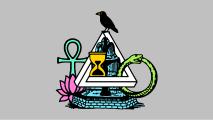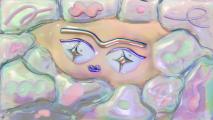Grief is a particular kind of trauma and its effects can be profound, disruptive, and bewildering. Among all the psychological symptoms of grief — which can include amnesia and a kind of “stepping outside of oneself” or dissociation — the loss of personal identity appears to be the most complicated. Most people define themselves to some degree through their relationships (father, mother, husband, wife), and the loss of the relational person, particularly a spouse or a child, precipitates a profound sense of confusion and loss of one’s sense of selfhood.
The process of reconstructing one’s self without the loved person is confounding. The memories, vocabulary, and life one built with the other are no more and thus, the linear sense of oneself, of one’s life narrative, is disrupted. Suddenly you’re the only person who remembers your history and your life. Many bereaved people describe the loss of a spouse as an amputation, and in a psychological sense, it is.
Grief never ends
In her book on grief, Before and After Loss: A Neurologist’s Perspective on Loss, Grief, and Our Brain (2018), written after the death of her husband, neurologist Lisa Schulman notes that seeing the psychological aspect of grief as a form of open-ended brain-altering trauma is not common in American culture, which places emphasis on “moving forward.” In fact, Schulman argues, American culture considers grieving a finite process which ends with “closure,” like a book, a movie, or TV series, with its “season or series finale.” “Closure” entails “moving on” and “letting go” of the dead, ceasing the habits that bind us to the departed, summing up their lives and their relationships with conclusive insights that no longer invite brooding reflection, ambiguity, or regrets. “Closure” delineates the line between healthy and unhealthy grief: without closure one is said to be stuck between the world of the living and the world of the dead, unable to “let go.”
In her book Closure: The Rush to End Grief and What it Costs Us (2011), sociologist Nancy Berns proposes that closure is an artificial, socially structured emotion that offers a false promise of completion and resolution. Unlike books and movies, grief is open-ended, without an expiration date; it leaves a permanent existential wound on one’s psyche: “grief never ends, and it is a natural response to loss.” The psychological connection with the dead provides recourse and allows integration of loss into the narrative of one’s life.
Grief as mythological narrative
For a long time, psychologists and psychiatrists viewed grief as a journey — a gradual process consisting of five stages: denial, anger, bargaining, depression, acceptance. But there is no chronology or linearity in grief; it does not progress along predetermined stages. There is no grief journey. Psychologists and grief experts Jason Holland and Robert Neimeyer suggest that the five-stage model continues to persist due to the underlying cultural framework of the “monomyth” — a.k.a. the Hero’s Journey — that dominates much of our storytelling.
The Hero’s Journey is a structural model of mythological narrative (popularized by writer Joseph Campbell) in which the hero is called upon to perform a challenging deed to save himself and/or his people. After a series of obstacles and setbacks, and with assistance from magical helpers, the hero ultimately succeeds, returning home wiser with newly acquired knowledge. Holland and Neimeyer note that, “This epic narrative structure is easily enough seen in popular depictions of ‘the griever’s journey,’ which like Campbell’s ‘monomyth’ commonly entail a shift in the protagonist’s spiritual center of gravity as he or she crosses a liminal threshold into an unknown and dangerous world, typically undergoing a personal metamorphosis as the journey proceeds, before reentering the known world transformed and bearing a special boon to confer on his or her fellows.” The monomyth model offers two things, closure and hope for triumphant, growth-oriented evolution toward recovery.
The dead never leave the living
But in most traditional cultures, the dead never leave the living, and the ties with the world of the dead are regularly maintained through a variety of performative rituals and celebrations. There is no closure to grief. All Saints Day in Poland, and Día de los Muertos in Mexico, for example, are intended to reaffirm our connection with the dead by visiting their graves as if they were still among us, just living separate and silent afterlives. During the Obon Festival in Japan, people display paper lanterns outdoors to guide the spirits of the dead back to Earth; they are believed to return for that time to eat the food prepared for them by their families. The lanterns are then sent down the river to help guide the spirits of the ancestors back to the afterlife. During the annual Egungun festival celebrated by the Yoruba people of West Africa (and in the African Diaspora, particularly in Brazil, Cuba, the Caribbean, and the U.S.), the spirits of departed ancestors are summoned through elaborate performance rituals to seek their counsel and advice.
In the Orthodox Church, the soul of the deceased wanders the Earth for the first two days after death, saying goodbye to the familiar places and people. On the third day, the day of burial, the soul starts a torturous journey to the afterlife during which it is faced with its sins and the demons (“biesy”) responsible for them. In Kabbalah, a form of Jewish mysticism, the dead are always present; their souls move among the living, making demands, entering and exiting their bodies, and influencing their lives. Jewish folklore is populated by various demons, dybbuks, and golems that restlessly wander the Earth atoning for their past sins.
In a way, these traditional religious rituals of the afterlife provide the traumatized brain with the comforting sense that the severance of the relationship brought by death is not finite but rather a temporary parting. Whether formalized through customs or religious or private performative gestures, the rituals of continuity have a neurological purpose. The human brain trains itself to predict the order and location of things — losing a person close to us disrupts this ingrained understanding. When you live with someone — say, a spouse or a child — for a long time, they become an extension of you, an extension of your virtual inner world. When they die, you are asked to imagine something your limited, human brain struggles to process.
The solace of continuity
As psychologist and grief researcher Mary-Frances O’Connor put it in her book The Grieving Brain: The Surprising Science of How We Learn From Love and Loss (2022): “Grief is a heart-wrenchingly painful problem for the brain to solve, and grieving necessitates learning to live in the world with the absence of someone you love deeply, who is ingrained in your understanding of the world.” To reconcile the contradiction between the reality of a person’s absence and the brain’s inability to absorb that knowledge, the brain often tricks us into a faux sense of continuity: the absence does not feel like a void, but only as a temporary separation.
The need for continuity has neurological, cultural, and philosophical dimensions. Since we are not able to immediately imagine the world without our loved one in it, we imagine some other alternative afterlife where they continue to exist in the virtual map of our brain. The neurons which attempt to locate them for comfort no longer misfire into the void but find solace in our imagination. Thus, the deceased are simultaneously gone but also everlasting.
This article was reprinted with permission of Big Think, where it was originally published.






